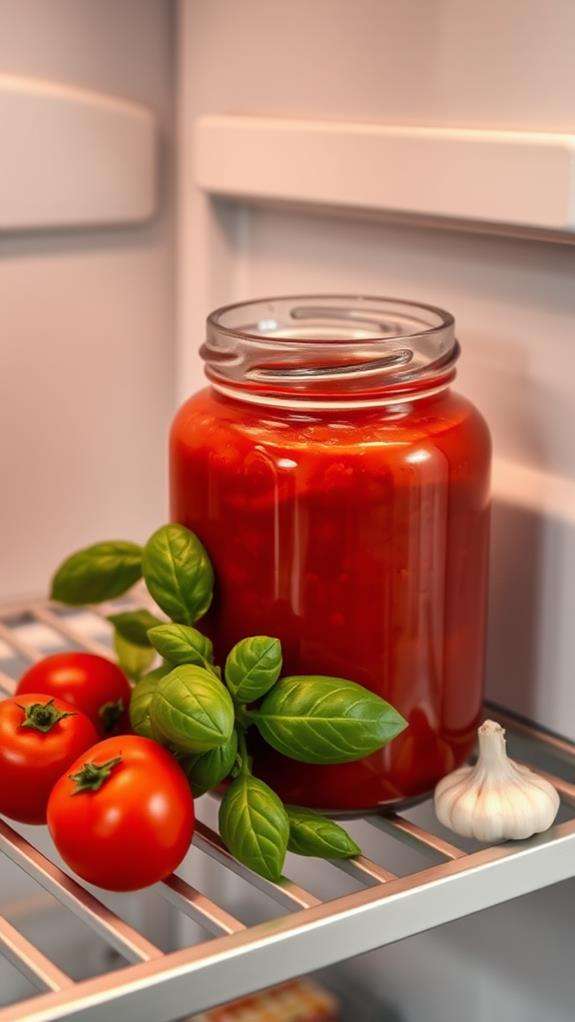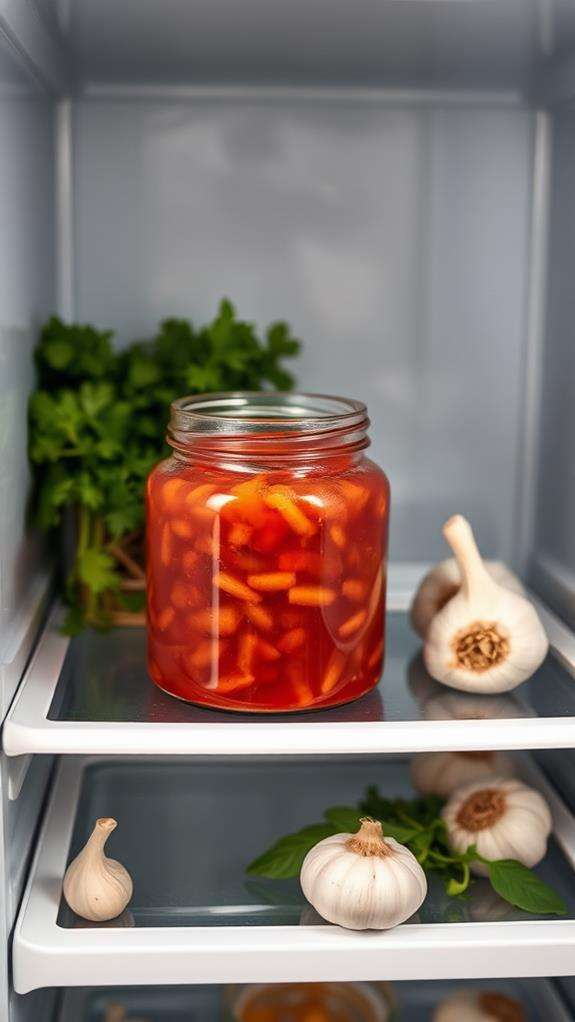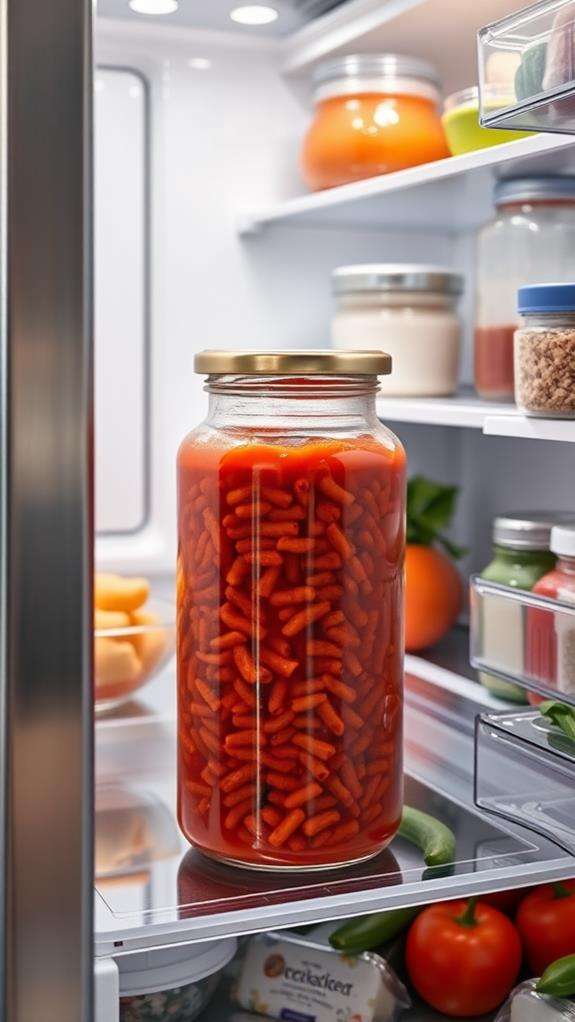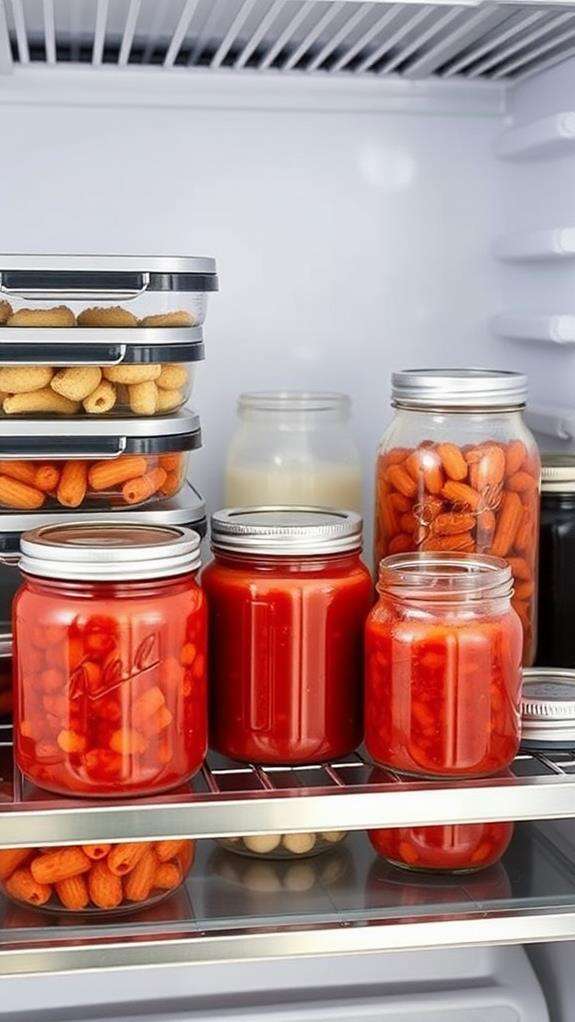How Long Does Prego Last in the Fridge
Properly stored Prego sauce will last 7-14 days in your refrigerator after opening, provided you maintain temperatures between 35-40°F. You’ll need to transfer the sauce to an airtight container or tightly seal the original jar, placing it on a middle shelf rather than in the door for consistent cooling. Watch for signs of spoilage like mold, discoloration, off-odors, or unusual texture changes, and always use clean utensils when serving to prevent contamination. While basic refrigeration works well for short-term storage, you’ve got several additional options to extend your sauce’s shelf life even further.
This post may contain affiliate links. If you make a purchase through these links, I may earn a commission at no additional cost to you. Additionally, portions of this post may be generated using artificial intelligence (AI) technology. While we strive for accuracy, please be aware that AI-generated content may not always be perfect and should be fact-checked when necessary.
The Spatula Scoops
- Properly stored Prego sauce typically lasts 7-14 days in the refrigerator when kept at a consistent temperature between 35-40°F.
- Store opened Prego in an airtight container on a middle shelf at the back of the fridge, not in the door.
- Check for signs of spoilage like mold, discoloration, off-odors, or unusual texture changes before each use.
- Use clean utensils when serving and seal the container tightly after each use to maximize shelf life.
- For longer storage beyond two weeks, consider freezing portions of Prego sauce for up to 6 months.
Storage Guidelines for Prego Sauce

Proper storage of Prego sauce greatly impacts its shelf life and quality. Once you’ve opened your jar of Prego, you’ll need to transfer any unused portion to an airtight container if you’re not using the original jar. When storing in the original jar, make sure you’ve wiped the rim clean and secured the lid tightly to prevent contamination and oxidation.
You’ll want to keep your Prego sauce in the refrigerator at a consistent temperature between 35-40°F (1.6-4.4°C). Don’t store the sauce in the door compartment, as temperatures there fluctuate more frequently when you’re opening and closing the fridge. Instead, place it on a middle shelf where the temperature remains more stable. If you’ve used a metal spoon or ladle to serve the sauce, verify it’s completely clean to avoid introducing bacteria into the remaining sauce.
For ideal freshness, you shouldn’t leave the sauce at room temperature for more than two hours. If you’re meal prepping, portion out what you’ll need and return the remainder to the fridge immediately. These storage practices will help maintain the sauce’s flavor, consistency, and food safety standards.
Signs of Spoiled Pasta Sauce

Even with careful storage, you’ll need to check your Prego sauce for signs of spoilage before using it. Watch for any discoloration, particularly darkening or unusual color variations that differ from the sauce’s original bright red appearance. If you notice any green, white, or black spots, these are likely signs of mold growth, and you should discard the sauce immediately.
The sauce’s texture can also indicate spoilage. If you see any separation that doesn’t remix with a quick stir, or if the sauce has become unusually thick or clumpy, it’s best to err on the side of caution and throw it away. Pay attention to the sauce’s aroma when you open the jar. Fresh Prego should smell like herbs, tomatoes, and seasonings. Any sour, fermented, or “off” odors suggest bacterial growth and mean the sauce isn’t safe to consume.
You might also notice pressure building up inside the jar, causing the lid to bulge or making a loud popping sound when opened. This indicates fermentation or bacterial activity, and the sauce should be discarded regardless of its appearance or smell.
Proper Refrigeration Techniques

To keep your Prego sauce fresh and safe, you’ll need to maintain a consistent refrigerator temperature between 35-38°F (1.7-3.3°C), as higher temperatures can promote bacterial growth. When storing your opened sauce, transfer it to an airtight container or securely seal the original jar with plastic wrap, ensuring no air pockets remain that could lead to premature spoilage. You should also position the sauce container on a middle shelf of your refrigerator, away from the door where temperature fluctuations are more common, and make sure to clean any sauce residue from the jar’s rim before sealing it.
Temperature Control Guidelines
Maintaining your Prego sauce at the right temperature is essential for maximizing its shelf life and safety. Your refrigerator should consistently maintain a temperature between 36°F and 40°F (2°C to 4°C), with 38°F (3.3°C) being the ideal target for sauce storage.
You’ll want to place your opened Prego container on a middle shelf rather than the door, as door temperatures can fluctuate considerably when you’re opening and closing the refrigerator. To monitor this effectively, you should keep a refrigerator thermometer in the same area where you store your sauce. If you’re transferring the sauce to another container, make sure it’s airtight and food-grade safe.
Don’t let your Prego sit out at room temperature for more than two hours, as the “danger zone” between 40°F and 140°F (4°C to 60°C) promotes bacterial growth. When serving, avoid leaving the sauce at room temperature for extended periods, and remember to use clean utensils each time you portion it out. After use, return the sauce promptly to the refrigerator and make sure the lid is tightly sealed to maintain proper temperature control.
Airtight Container Storage
Proper storage of Prego sauce in an airtight container considerably extends its shelf life and maintains its quality. When you’re transferring your leftover sauce, it’s essential to select a container that seals completely and prevents air from entering. Glass or BPA-free plastic containers with secure lids work best for storing your Prego sauce, as they protect against both bacterial growth and freezer burn if you decide to freeze portions for later use.
- Choose a container that’s slightly larger than your sauce volume to minimize air space, but leave about 1/2 inch of headroom for expansion
- Clean the container’s rim and lid thoroughly before transferring the sauce to prevent contamination
- Press plastic wrap directly onto the sauce’s surface before sealing if you’re concerned about film formation
- Label your container with the date you opened the original Prego jar and the transfer date
Remember that even with perfect container selection, you’ll need to check for signs of spoilage before each use. If you notice any unusual odors, discoloration, or mold growth when opening your stored sauce, it’s best to discard it immediately.
Extending Prego Shelf Life

You’ll get the most out of your Prego sauce by selecting an airtight glass or plastic container that’s appropriately sized for your leftovers, which helps prevent unnecessary air exposure and bacterial growth. Maintaining consistent refrigerator temperatures between 35-38°F (1.7-3.3°C) is essential for preserving your sauce’s quality, so consider using a refrigerator thermometer to monitor the conditions. To minimize air exposure when storing partial portions, you can press plastic wrap directly onto the sauce’s surface before sealing the container, effectively creating a barrier against oxidation and moisture loss.
Proper Storage Container Selection
Selecting the right storage container plays an essential role in maximizing your Prego sauce’s shelf life. When you’re transferring leftover sauce from the original jar, you’ll want to choose an airtight container that’s specifically designed for refrigerator storage. Glass containers with snap-locking lids typically offer the best protection against air exposure and potential contamination, while maintaining the sauce’s original flavor profile.
- Use BPA-free plastic or glass containers with rubber-sealed lids to prevent oxidation and maintain freshness
- Select containers that are appropriately sized for your leftover amount, minimizing excess air space
- Choose containers with wide openings for easy cleaning and sauce removal
- Opt for transparent containers that allow you to monitor the sauce’s condition without opening
If you don’t have dedicated storage containers, you can continue using the original Prego jar, ensuring you’ve wiped the rim clean and secured the lid tightly. Whatever container you choose, it’s vital to avoid leaving metal utensils in the sauce or storing it in reactive metal containers, as these can affect both taste and safety. Remember to label your container with the date you opened the sauce to track its freshness effectively.
Temperature Control Methods
Maintaining ideal temperature control stands as the cornerstone of preserving your Prego sauce’s freshness and safety. You’ll need to keep your refrigerator at a consistent temperature between 35-38°F (1.7-3.3°C) to maximize your sauce’s shelf life. Using a refrigerator thermometer, you can monitor and adjust settings as needed to maintain best conditions.
| Temperature Zone | Impact on Sauce | Recommended Action |
|---|---|---|
| Below 32°F | Ice crystals form | Adjust temp higher |
| 35-38°F | Best preservation | Maintain setting |
| Above 40°F | Bacterial growth risk | Lower temp immediately |
When transferring Prego from pantry to fridge, you shouldn’t let it sit at room temperature for more than two hours. If you’re serving the sauce, keep track of how long it stays out of refrigeration. You’ll want to place the container toward the back of your fridge, where temperatures remain most stable, rather than in the door compartment where fluctuations occur frequently. Consider using an appliance thermometer in different areas of your refrigerator to identify cold and warm spots, helping you choose the best storage location.
Minimize Air Exposure Tips
Beyond temperature control, proper air exposure management plays a key role in keeping your Prego sauce fresh. When oxygen interacts with your sauce, it can accelerate bacterial growth and compromise the product’s quality. You’ll want to implement specific strategies to minimize air contact with your opened Prego sauce.
- Transfer your sauce to an airtight container that’s appropriately sized for the remaining amount, guaranteeing minimal headspace between the sauce and lid.
- Use a clean silicone spatula to scrape down the sides of the original jar before transferring, preventing waste and reducing surface area exposed to air.
- Consider using plastic wrap pressed directly onto the sauce’s surface before securing the container’s lid, creating an additional barrier against oxidation.
- Always clean the jar’s rim thoroughly before closing to maintain an airtight seal, and avoid repeatedly opening and closing the container.
Remember to select containers with tight-fitting lids and proper sealing mechanisms. If you’re storing a small amount, opt for a smaller container rather than keeping it in the original large jar. This approach reduces the air pocket above the sauce, which can notably impact its shelf life and quality.
Food Safety Best Practices

Safe handling of Prego sauce requires following essential food safety practices to prevent foodborne illness. You’ll need to maintain proper temperature control by keeping your refrigerator at or below 40°F (4°C), and you should always use clean utensils when serving the sauce to prevent cross-contamination.
When handling Prego, you’ll want to check for signs of spoilage before each use, including unusual odors, discoloration, or mold growth. Don’t taste the sauce to test if it’s spoiled, as this could make you sick. You should also keep track of when you first opened the jar by marking the date on the lid with a permanent marker.
Remember to always use a clean spoon when serving, and never put used utensils back into the jar. If you’re transferring the sauce to another container, make sure it’s thoroughly cleaned and sanitized first. Don’t leave Prego sauce at room temperature for more than two hours, as this creates an ideal environment for bacterial growth. When reheating leftover sauce, ascertain it reaches 165°F (74°C) throughout before serving.
Alternative Storage Methods

When traditional refrigeration isn’t available, you can explore several reliable methods to store Prego sauce effectively. These alternative storage solutions can help maintain the sauce’s quality and extend its shelf life, though you’ll need to monitor each method carefully to guarantee food safety standards are met.
- Vacuum sealing – Transfer your Prego sauce into vacuum-sealed bags, which can be stored in a cool, dark place for up to 2 months without refrigeration
- Canning process – Use proper sterilization techniques and mason jars to preserve the sauce through a water bath canning method, extending shelf life to 12-18 months
- Freezer storage – Convert your Prego into convenient portion-sized freezer bags or containers, where it’ll last up to 6 months
- Cool storage alternatives – Utilize a root cellar, basement, or specialized food storage containers with temperature-control features for short-term storage
You’ll want to guarantee proper temperature monitoring with any alternative method you choose. Consider investing in a food thermometer to track storage conditions, and always check for signs of spoilage before consumption, regardless of your chosen preservation method.
Frequently Asked Questions
Can Prego Sauce Be Frozen in Its Original Glass Jar?
You’d think glass jars would be perfect for freezing sauce, but ironically, it’s not a safe choice. You shouldn’t freeze Prego in its original glass jar because liquids expand when frozen, which can cause the jar to crack or shatter. Instead, transfer your sauce to freezer-safe plastic containers or heavy-duty freezer bags, leaving about an inch of headspace for expansion. When properly stored in appropriate containers, Prego sauce can be frozen for up to 3 months.
Does Adding Olive Oil on Top Help Preserve Opened Prego Longer?
Adding olive oil on top of your opened Prego sauce won’t greatly extend its shelf life. While this technique works for some homemade sauces, commercial Prego already contains preservatives and stabilizers that are more effective. You’ll get better results by storing your sauce properly: keep it tightly sealed, refrigerated at 40°F or below, and use it within 7-10 days of opening. If you can’t use it in time, freezing is your best preservation option.
Why Does Prego Sometimes Separate After Being Refrigerated?
You’ll notice separation in Prego sauce because its ingredients have different densities, and when left undisturbed in the fridge, they naturally settle into layers. The tomato solids sink to the bottom while water and oils rise to the top. This separation isn’t harmful – it’s just physics at work. You’ll also see this happen faster if your sauce experiences temperature fluctuations, which can affect the stability of the emulsion.
Can I Mix Different Prego Flavors and Store Them Together?
Prudently partnering Prego’s different flavors can work, but you’ll want to contemplate a few factors. While mixing varieties isn’t harmful, it could affect the sauce’s consistency and storage time. You’re better off keeping flavors separate to maintain their distinct tastes and textures. If you do combine them, use within 3-5 days and store in an airtight container. Remember, mixed sauces might separate more quickly in the fridge.
Does Transferring Prego to Plastic Containers Affect Its Shelf Life?
When you transfer Prego sauce to plastic containers, you won’t greatly affect its shelf life if you’re using clean, airtight containers and proper storage techniques. However, you’ll want to avoid using containers that aren’t food-grade or have lingering odors, as these can impact the sauce’s quality. You can expect the same 3-5 day refrigerated shelf life as the original jar, provided you’re storing it at the proper temperature (40°F or below).





